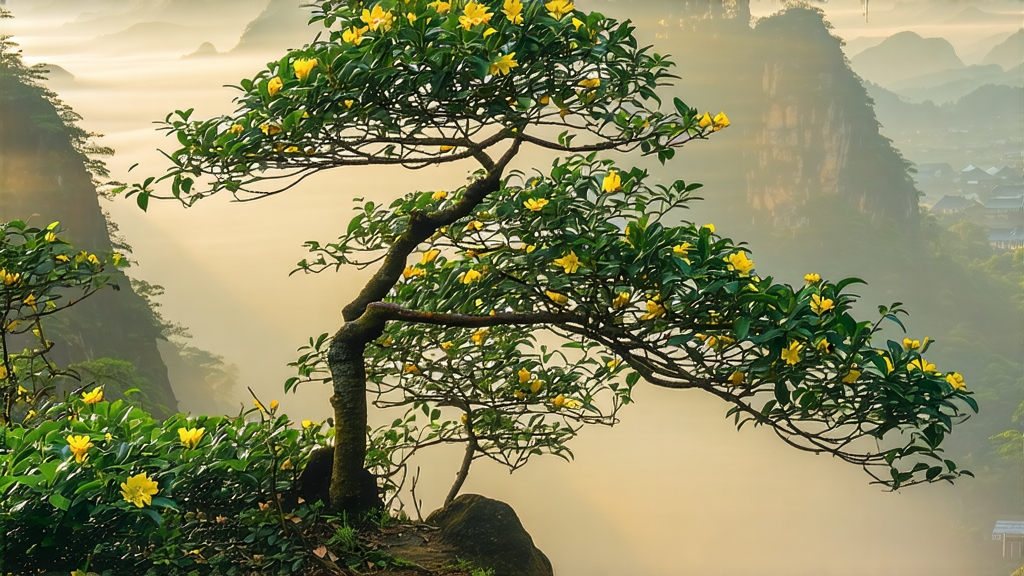
Tucked away in the cloud-veiled peaks of Sichuan’s Meng Ding Shan, a tea once reserved for emperors still follows a rhythm set by the lunar calendar rather than the market. Meng Ding Huang Ya—literally “Meng Summit Yellow Bud”—is the least-known member of China’s six great tea families, yet it carries the most delicate secret in the world of camellia sinensis: the art of “sealed yellowing,” a slow enzymatic waltz that turns green into gold without ever touching fire. For the international drinker accustomed to the bright snap of green tea or the muscular depth of pu-erh, Huang Ya offers a third path, a liquid amber that smells of fresh alfalfa, steamed corn milk, and mountain orchids, then lingers on the palate like warm custard. Understanding it requires stepping back 1,200 years to the Tang dynasty, forward to the microscopic choreography of leaf chemistry, and sideways into the quiet courtyards where farmers still whisper to their bamboo baskets.
Historical whispers
The first written record appears in 808 CE, when the monk Meng Jiao presented “yellow sprouts from the summit” to Emperor Xianzong. The tribute system formalized two centuries later under the Song court demanded exactly 365 buds—one for each day of the year—picked only between Qing Ming and Grain Rain, when the morning mist is cool enough to keep the leaf cells closed. Caravans carried the tea down the Min River to Chengdu, then along the ancient tea-horse road to Tibet, where nomads exchanged warhorses for its calming sweetness. When the Qing dynasty collapsed in 1911, imperial demand vanished; mountain monks quietly kept the seeds in temple gardens, and for seventy years Meng Ding Huang Ya survived as a whispered legend rather than a commodity. Its renaissance began in 1978 when agronomist Wang Zhifeng rediscovered three ancient mother trees hidden behind a waterfall at 1,450 m. Cuttings from those trees now supply fewer than 3,000 kg of finished tea per year—less than one day’s output from a single Longjing village.
Micro-terroir in the sky
Meng Ding Shan is a narrow granite spine that punches through the Sichuan basin to catch the Indian monsoon. At 1,400–1,550 m the average temperature is 5 °C lower than the valley floor, slowing photosynthesis and doubling the amino acid content in the buds. Night fogs roll up the western cliff at 2 a.m., coating leaves with a film of water that acts like liquid shade, suppressing tannin and coaxing the formation of theanine. Soil is a shallow layer of phyllite weathered into quartz-rich loam; its low phosphorus forces the roots to forage horizontally, producing smaller cells and therefore more tender pluck. The result is a bud only 12–15 mm long, shaped like a sparrow’s tongue, covered in silvery down that turns primrose during yellowing.
The craft: seven steps to gold
- Picking: “one bud, one leaf just unfurling” is picked between 5:30 and 9:00 a.m., while the leaf temperature is still below 18 °C. Experienced pluckers use only thumb and middle finger to avoid the heat of the palm.
- Withering: the harvest is laid on bamboo trays inside a mountain hut whose windows are shuttered to 30 % light. For four hours the leaf loses 8 % moisture, softening cell walls without oxidizing.
- Fixation: wok temperature is precisely 160 °C for 90 seconds—hot enough to kill the grassy lipoxygenase pathway, yet cool enough to leave 15 % residual enzyme activity that will drive yellowing. The master listens for the “popcorn crackle” that tells him the leaf is ready.
- Rolling: the warm leaves are rolled under palm pressure into tight spirals; cell breakage is limited to 30 % to protect the downy hairs that store aroma precursors.
- Sealed yellowing: the heart of the craft. The rolled leaf is wrapped in steamed yellow paper, then buried inside a lacquer box lined with cedar shavings. Every 24 hours the bundle is opened, gently fluffed, and rewrapped. Over 60–72 hours the chlorophyll degrades into pheophytin, catechins dimerize into theaflavins, and a golden pigment forms on